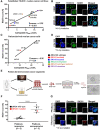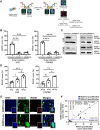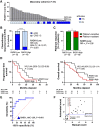RAD51 Foci as a Biomarker Predictive of Platinum Chemotherapy Response in Ovarian Cancer
- PMID: 37097615
- PMCID: PMC10320470
- DOI: 10.1158/1078-0432.CCR-22-3335
RAD51 Foci as a Biomarker Predictive of Platinum Chemotherapy Response in Ovarian Cancer
Abstract
Purpose: To determine the ability of RAD51 foci to predict platinum chemotherapy response in high-grade serous ovarian cancer (HGSOC) patient-derived samples.
Experimental design: RAD51 and γH2AX nuclear foci were evaluated by immunofluorescence in HGSOC patient-derived cell lines (n = 5), organoids (n = 11), and formalin-fixed, paraffin-embedded tumor samples (discovery n = 31, validation n = 148). Samples were defined as RAD51-High if >10% of geminin-positive cells had ≥5 RAD51 foci. Associations between RAD51 scores, platinum chemotherapy response, and survival were evaluated.
Results: RAD51 scores correlated with in vitro response to platinum chemotherapy in established and primary ovarian cancer cell lines (Pearson r = 0.96, P = 0.01). Organoids from platinum-nonresponsive tumors had significantly higher RAD51 scores than those from platinum-responsive tumors (P < 0.001). In a discovery cohort, RAD51-Low tumors were more likely to have a pathologic complete response (RR, 5.28; P < 0.001) and to be platinum-sensitive (RR, ∞; P = 0.05). The RAD51 score was predictive of chemotherapy response score [AUC, 0.90; 95% confidence interval (CI), 0.78-1.0; P < 0.001). A novel automatic quantification system accurately reflected the manual assay (92%). In a validation cohort, RAD51-Low tumors were more likely to be platinum-sensitive (RR, ∞; P < 0.001) than RAD51-High tumors. Moreover, RAD51-Low status predicted platinum sensitivity with 100% positive predictive value and was associated with better progression-free (HR, 0.53; 95% CI, 0.33-0.85; P < 0.001) and overall survival (HR, 0.43; 95% CI, 0.25-0.75; P = 0.003) than RAD51-High status.
Conclusions: RAD51 foci are a robust marker of platinum chemotherapy response and survival in ovarian cancer. The utility of RAD51 foci as a predictive biomarker for HGSOC should be tested in clinical trials.
©2023 The Authors; Published by the American Association for Cancer Research.
Figures





References
-
- Lheureux S, Gourley C, Vergote I, Oza AM. Epithelial ovarian cancer. Lancet 2019;393:1240–53. - PubMed
-
- Swisher EM, Lin KK, Oza AM, Scott CL, Giordano H, Sun J, et al. . Rucaparib in relapsed, platinum-sensitive high-grade ovarian carcinoma (ARIEL2 part 1): an international, multicentre, open-label, phase 2 trial. Lancet Oncol 2017;18:75–87. - PubMed
-
- Mirza MR, Monk BJ, Herrstedt J, Oza AM, Mahner S, Redondo A, et al. . Niraparib maintenance therapy in platinum-sensitive, recurrent ovarian cancer. N Engl J Med 2016;375:2154–64. - PubMed
Publication types
MeSH terms
Substances
Grants and funding
LinkOut - more resources
Full Text Sources
Other Literature Sources
Medical
Research Materials

